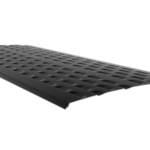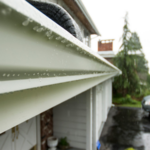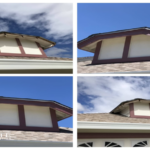- The minimum slope for gutters should be ½ inch per foot.
- Gutters should be installed with a minimum of two support hangers per 10 feet of gutter.
- End caps, drop outlets, and miters should be sealed with silicone caulk or sealant tape.
- All seams should be sealed with either sealant tape or silicone caulk.
- All hangers should be installed with screws, not nails.
- Gutters should be cleaned out at least twice a year to prevent debris buildup.
By following these latest gutter installation standards, you can be sure that your gutters will be properly installed and will function as they should.
What is the rule of thumb for gutter installation?
There is no set “rule of thumb” for gutter installation, as the specific needs of each home will vary depending on factors such as the size and type of roof, the climate, and the amount of rainfall the home receives. However, there are some general guidelines that can be followed in most cases. For example, it is generally recommended that gutters be installed at a slope of at least 1/4 inch per foot, in order to ensure that water can properly drain away from the home. Additionally, it is important to make sure that the gutters are properly secured to the roof and are not blocked by debris, in order to avoid any problems with water damage.
How do you prepare new gutters?
- You will need to purchase gutters that are the correct size for your home. You can do this by measuring the length and width of your home and then finding gutters that are the same size.
- Once you have your gutters, you will need to clean them before you install them. This means removing any dirt, debris, or leaves that may be on them.
- Next, you will need to install the gutters. This can be done by attaching them to the fascia board on your home. You will need to use screws or nails to do this.
- After the gutters are installed, you will need to connect them to the downspouts. This can be done by using clamps or hangers.
- Finally, you will need to test the gutters to make sure they are working properly. This can be done by running water from a hose through them.
What should you not do when installing gutters?
- Don’t use the wrong type of fastener. When attaching gutters to your home, it’s important to use the right type of fastener. Nails are not recommended, as they can easily come loose and cause gutters to sag or fall off. Instead, use screw-in or spike-and-ferrule hangers.
- Don’t make the gutters too steep. If gutters are too steep, water will run off too quickly and won’t have a chance to be properly diverted. This can cause gutters to overflow, and the water can damage both the gutters and your home.
- Don’t forget to install a downspout. A downspout is essential for diverting water away from your home and Foundation. Without one, water can pool around your home, causing serious damage.
- Don’t forget to clean your gutters. Gutters need to be regularly cleaned to avoid buildup of leaves, sticks, and other debris. This can cause gutters to clog and overflow, and can also lead to serious damage to your home.
How far can a gutter go before a downspout?
A gutter can go as far as 20 feet before a downspout is needed. Downspouts are needed to direct the water away from the foundation of the house and to prevent water from pooling around the base of the house. Gutters are usually installed at the time of the house construction but can be added to an existing house.
How much standing water in gutter is OK?
This is a difficult question to answer because it depends on a number of factors. The type of gutter, the age of the gutter, the climate, and the amount of rainfall are all important factors to consider.
If you have a new gutter, it is probably best to err on the side of caution and not allow any standing water to accumulate. However, if you have an older gutter, it may be more tolerant of some standing water.
In general, it is best to avoid any standing water in your gutters, especially if you live in an area with a lot of rainfall. If you do have some standing water, you should check the gutters regularly to make sure they are not clogged and to ensure that the water is draining properly.
How do I calculate how much gutters I need?
The first thing you need to do is measure the length of your home’s exterior walls. Once you have that measurement, you need to decide how many inches of rainfall you want your gutters to be able to handle. For example, if you live in an area with a lot of rainfall, you might want to choose gutters that can handle 5 inches of rainfall.
Once you have your measurement and your rainfall amount, you need to find a gutters calculator online. There are many different gutters calculators available, so you can choose the one that you feel is the most user-friendly.
Once you enter your information into the calculator, it will give you a number of different options for gutters. It is important to choose the option that is the best fit for your home. If you have a lot of trees near your home, you might want to choose a gutter that has a higher capacity so that it does not get clogged with leaves.
Do I need 6 or 7 inch gutters?
It depends on the size of your home and the amount of rainfall in your area. If you have a small home and live in an area with little rainfall, then 6 inch gutters should be sufficient. If you have a large home or live in an area with a lot of rainfall, then you may need 7 inch gutters.
How much should a gutter drop every 10 feet?
A gutter should drop about 2 inches for every 10 feet to allow proper drainage. If your gutters are dropping more than this, they may be clogged and need to be cleaned. If your gutters are dropping less than this, they may not be draining properly and could cause water damage to your home.
Final Talk
If you’re thinking about getting new gutters installed, it’s important to stay up-to-date on the latest standards. By doing so, you can be sure that your gutters will be properly installed and will function as they should. Keep an eye on the latest gutter installation standards so that you can be sure your home is protected from the elements.















